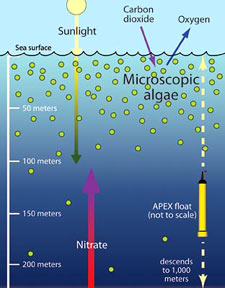Open ocean plants get food from the depths
October 14th, 2010 | by Malamalama Staff | Published in Research News | 1 Comment

Microscopic algae in surface waters depend on nitrate, only available in deep waters; graphic by Kim Fulton-Bennett, Monterey Bay Aquarium Research Institute
Microalgae need nitrate, yet the microscopic plants flourish in open ocean areas where the nutrient is scarce. To figure out how, UH Mānoa oceanographer David Karl and colleagues from the Monterey Bay Aquarium Research Institute and University of Washington used an Apex float outfitted with sensors to measure concentrations of oxygen and nitrogen in the water column northeast of Oʻahu.
For two years, the robotic drifter bobbed to a depth of 1,000 meters and back every five days. From January to October each year, oxygen concentrations increased in the upper 100 meters, where algae find sufficient sunlight to grow. At the same time, nitrate concentrations in deeper waters declined at a rate consistent with algal growth rates observed in that part of the Pacific.
Writing in the June 24 issue of Nature, the scientists suggest that ocean eddies carry nitrate as high as 70 meters below the surface, where microalgae consume it and swim or float to shallower depths. They plan to deploy more drifters near Hawaiʻi, Bermuda and in the mid-Atlantic. Understanding the process at work is important, says Karl. Not only do the algae produce oxygen, but they consume about a fifth of all the carbon dioxide taken up plants, carrying it to the ocean bottom when they die and sink.
Read the editor’s summary in Nature.
Tags: algae, oceanography, UH Manoa, Vol. 35 No.2

January 14th, 2011at 2:53 pm(#)
This is to Dave Karl.
Great work Dave. Wish I was still in HI working on microbial oceanography. I don’t know if you remember me. I was Berger’s student and taught at RPI. Met you when you were studying in Florida.
Keep up the good work.
Dan Pope